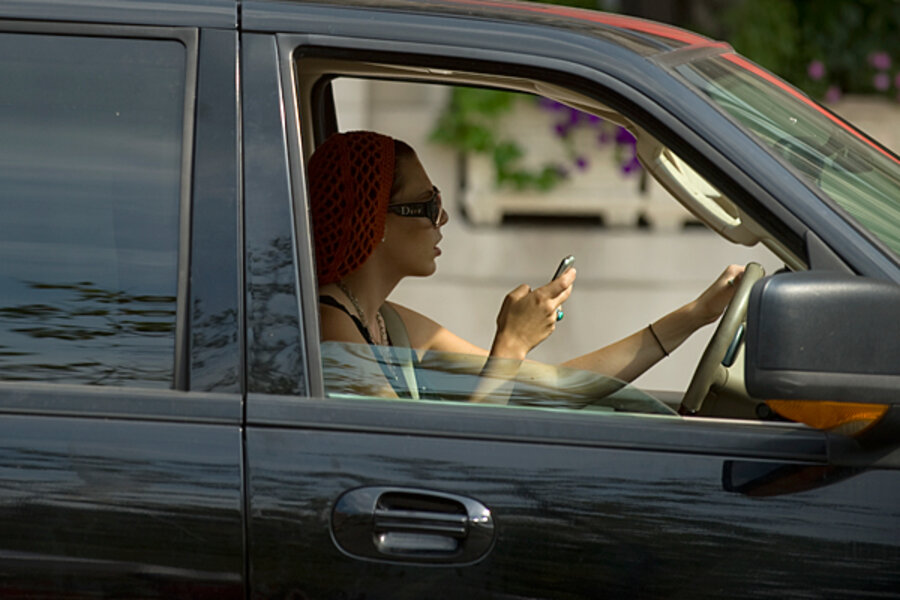Bans on texting while driving don't reduce crashes, study says
Loading...
State laws prohibiting texting while driving have not reduced car crashes, and in some places may have actually increased the number of accidents, says new safety research released Tuesday.
The findings, which have intensified the debate over how to combat the problem of distracted driving, come from the Highway Loss Data Institute and are scheduled to be presented at Tuesday’s annual meeting of the Governors Highway Safety Association.
US Department of Transportation Secretary Ray LaHood called the study “misleading,” and released a statement saying that his department’s research showed that distracted driving laws could, in fact, reduce crashes.
Secretary LaHood has made the growing campaign against “distracted driving” – a category that can include everything from adjusting the car radio to talking on a cellphone – one of his pet causes. Last week, his department hosted the second annual Distracted Driving Summit, during which he praised states for implementing more laws against cellphone use behind the wheel, and called for increased regulations to combat what he termed an “epidemic” on America’s roads. Thirty states plus Washington, D.C., now prohibit texting while driving.
While safety researchers agree that texting behind the wheel is dangerous, concern is growing that cellphone laws do not equal safer roads.
“There is a lot of media attention on the topic in general, but it’s difficult to find specific policy solutions,” says Fernando Wilson, an assistant professor at the University of North Texas in Denton. Last week, his study showing that texting while driving had increased auto fatalities by more than 16,000 between 2001 and 2007 was published in the American Journal of Public Health.
“It’s a much more difficult enforcement problem than drunk driving, for instance," he says. "A driver will drive normally for a long period of time, then erratically for short periods of time when they’re texting. With drunk driving you can use check points – you can’t do that so much with cellphone use.”
The new study from the Highway Loss Data Institute, which is funded by insurers, also suggests problems with enforcement of the bans, says Anne Fleming, spokeswoman for the affiliated Insurance Institute for Highway Safety.
“There are various issues, and enforcement is definitely one of them,” she says. “It’s difficult to see if someone is using a phone. It’s definitely difficult to see if they’re texting. And if drivers don’t believe they are going to be caught, compliance isn’t as high.”
A recent study from the Automobile Club of Southern California, for instance, found that texting while driving doubled in California after the state implemented its January 2009 texting ban. And drivers who do adhere to texting bans might be replacing one distracted driving behavior with another, Ms. Fleming says.
“The trouble is that texting and using a cellphone while driving is definitely hazardous,” she says. “Nobody argues that. The danger in putting all the emphasis on laws is that it is being done to the exclusion of something else that would be more effective.”
Many safety experts say technological solutions such as anticollision devices in cars, or GPS tracking tools that let parents monitor their teenagers’ cellphone use, could be most effective in fighting texting while driving.
The research presented Tuesday analyzes insurance claims in four states, and compares crash numbers before and after those states passed antitexting laws. It also compares those numbers with data from neighboring states that did not have texting bans. In each of the antitexting states – Washington, Minnesota, California, and Louisiana – crash numbers either remained the same or increased. And in all four, accidents increased among drivers younger than 25 – the group most likely to text behind the wheel. The researchers speculated that if texting drivers held their phones lower to avoid detection, the amount of visual distraction increased significantly.
The results “call into question the way policy-makers are trying to address the problem of distracted driving crashes,” said Adrian Lund, president of the Insurance Institute for Highway Safety, in a statement. “They’re focusing on a single manifestation of distracted driving and banning it. This ignores the endless sources of distraction and relies on a ban … to solve the whole problem.”





